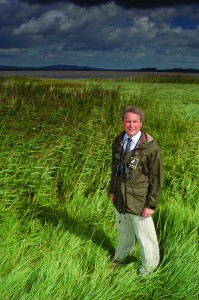Dredging report welcomed by WWT
Floods continue to cause misery across the country, especially southern England.
A report published today by leading water engineers clarifies the effectiveness of dredging – both in the Somerset Levels and nationally. The CIWEM report concludes that, while it could be beneficial in certain circumstances, dredging can also be ineffective or even damaging. You can read the report here.
It’s an issue close to WWT’s heart because it has such an impact on wetlands. We wrote about it last July (read here). WWT wholeheartedly endorses today’s CIWEM report, and that using natural processes - like wetlands - to manage water is a more effective long-term solution for flooding than inappropriate dredging.

WWT’s Chief Executive Martin Spray takes up the story:
"Dredging the Parrett and Tone won’t stop the Somerset Levels and Moors flooding in future and wouldn’t have stopped it now. Unregulated dredging across the rest of the country could actually make flooding worse.
"As shocking as that might sound - given the recent faith placed in dredging - that’s the conclusion of an assessment published today of dredging in Somerset and elsewhere. Politicians have genuinely needed to be seen to take decisive action, and dredging was the first thing to hand. But the technical assessment concludes dredging isn’t a silver bullet.
"That’s not to say dredging can’t be useful, even essential. Sometimes water does need to be speeded up so it doesn’t collect where we don’t want it, but those will be specific circumstances.
"Refreshingly, today’s report doesn’t enter the political blame game. It assesses dredging. It then lists other solutions which could be more widely effective in future. Solutions like using wetland and woodland strips to store water and release it slowly so that rivers and channels aren’t overloaded.
"So why isn’t dredging the cure-all? Imagine the Moors and Levels are a bath tub, with the bottom – the flood plain - now fully covered in water. Given the size of the channels compared to the flood plain as a whole, dredging them would be like scoring the bottom of the bath with a coin. It doesn’t make any significant difference to the overall water level.
"Nationally, dredging presents a different problem because, unlike in the relatively flat Levels, water is usually moved downhill by gravity. Dredging speeds up the flow. In the south east for example, imagine if all the tributaries into the upper Thames were dredged? All the water currently dispersed across the catchment would now be speeding into Maidenhead and Windsor and they’d be even more inundated with flood water than they are already.
"None of this is new information. After the devastating floods in eastern counties in 2007, a review was ordered which concluded “Waiting for another serious event is a dangerous ‘strategy of luck’; we need to act now to protect the future”.
"For a while we did. We now have flood maps and warning systems. A law was even passed which recognised a river is just part of its catchment and new properties should store rain run-off on site so they don’t overload drains emptying into the nearest river. But like many of the lessons from 2007, that law was never implemented and we now have to agree ways forward.
"All water engineers agree that natural features – like strategically placed wetlands and forest strips – are effective in tackling flooding, and this is already being embraced abroad. The Wildfowl & Wetlands Trust is designing and creating wetland flood protection schemes commissioned by governments around the world.
"In Laos we’re building wetlands that capture and treat waste water flowing from its capital city into the drainage canals. In Colombo, Sri Lanka, our consulting arm is designing a wetland scheme that will help to reduce flooding and pollution, as well as attracting tourism and wildlife.
"We’re doing the same in the UK. We’re building wetland systems that help farmers by cleaning silt and pollution from farm run-off before it reaches our drainage channels. And in urban landscapes we’re creating absorbent natural features like soakaways, green roofs and ponds that store rain water where it falls rather than rushing it to our rivers. With our expertise at managing 6,500ha of wetland at Slimbridge and elsewhere, we can make these features great for Britain’s biodiversity as well as for Britain’s people.
"And to its credit, the UK Government is already taking notice and looking at these techniques on a larger scale. It’s commissioned a new £20m working wetland at Steart, at the mouth of the River Parrett. This will provide local flood relief, grazing land, fish stocks and a public nature reserve. It will offset the destruction of other wetland in the Severn Estuary, so that flood defences can be maintained to protect thousands of urban and rural homes and businesses. It will provide between £0.5-1m of services to the community every year.
"Steart working wetland will contribute to the £1.9bn worth of flood defence already provided by the UK’s wetlands every year – for free – by buffering us against the sea or storing fresh water. That dwarfs any figure for structural investment quoted in the last week. As a rural business based in the South West, WWT is proud to be central to the design and future management of this new landscape benefitting people and wildlife.
"By working with nature at a catchment level, we harness its power for us rather than against us. As today’s report confirms, long-term solutions for flooding do already exist if we’re brave enough to embrace them."

